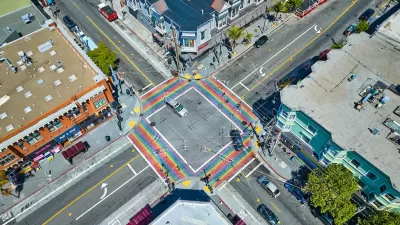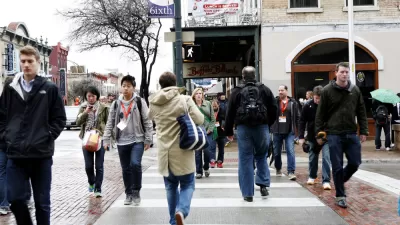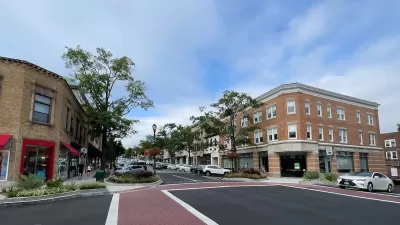Pedestrian and civil rights advocates have long argued that jaywalking laws are overly punitive and unequally enforced.

"On September 8, the California Senate advanced a bill that would eliminate fines for crossing the street outside of a crosswalk — the practice better known as jaywalking." Caro Jauregui and Mike McGinn write that this comes as part of a wave of reforms around the country that seek to eliminate discrimination and unequal enforcement.
In March, Virginia led off by striking jaywalking as a primary offense — police can no longer stop pedestrians specifically for jaywalking. Kansas City, Missouri, followed by eliminating its local jaywalking ordinance in May. A Nevada law went into effect last week striking the offense from its criminal code. Similar legislation has even been introduced in Texas, after an 18-year-old Black man in Plano was arrested and jailed overnight for walking in the roadway as he tried to make his way home in a snowstorm after his shift at Walmart.
Pedestrian advocates like Jauregui and McGinn have long argued that, far from improving public safety, jaywalking laws are "often used by police as a pretext for stopping people who 'look suspicious,'" sometimes resulting in police violence. "Data from the California Racial and Identity Profiling Act (RIPA) collected by the bicycle advocacy group CalBike shows Black people in California are over five times more likely to be stopped for a walking infraction than white people."
The proliferation of jaywalking laws is a particularly American phenomenon. "Although most of our (safer!) peer nations in Europe have no corresponding rule, jaywalking laws are ubiquitous in U.S. cities. As University of Virginia historian Peter Norton has written, these regulations date back to the beginning of the automotive era, when they were introduced by car-industry-aligned groups eager to shift blame for fatal crashes from drivers to pedestrians."
While "[e]liminating these laws represents an enormous shift in the way we think about safety, responsibility, power and ownership in public rights of way," data from Virginia shows that "[i]n the first six months since the rules changed, Department of Motor Vehicles records show that the rate of pedestrian injuries or fatalities across the state appears to be unaffected."
As Jauregui and McGinn assert, achieving pedestrian safety will take more effort on the part of policymakers and regulators. "Part of the solution will involve investments in better infrastructure — especially in lower income and Black and Latino neighborhoods, whose residents face traffic violence at a disproportionate rate." Reducing the alarming rise in pedestrian deaths requires "collective commitment and a rejection of the broken existing paradigm."
FULL STORY: It’s Time for California to Decriminalize Jaywalking

Study: Maui’s Plan to Convert Vacation Rentals to Long-Term Housing Could Cause Nearly $1 Billion Economic Loss
The plan would reduce visitor accommodation by 25,% resulting in 1,900 jobs lost.

North Texas Transit Leaders Tout Benefits of TOD for Growing Region
At a summit focused on transit-oriented development, policymakers discussed how North Texas’ expanded light rail system can serve as a tool for economic growth.

Why Should We Subsidize Public Transportation?
Many public transit agencies face financial stress due to rising costs, declining fare revenue, and declining subsidies. Transit advocates must provide a strong business case for increasing public transit funding.

How to Make US Trains Faster
Changes to boarding platforms and a switch to electric trains could improve U.S. passenger rail service without the added cost of high-speed rail.

Columbia’s Revitalized ‘Loop’ Is a Hub for Local Entrepreneurs
A focus on small businesses is helping a commercial corridor in Columbia, Missouri thrive.

Invasive Insect Threatens Minnesota’s Ash Forests
The Emerald Ash Borer is a rapidly spreading invasive pest threatening Minnesota’s ash trees, and homeowners are encouraged to plant diverse replacement species, avoid moving ash firewood, and monitor for signs of infestation.
Urban Design for Planners 1: Software Tools
This six-course series explores essential urban design concepts using open source software and equips planners with the tools they need to participate fully in the urban design process.
Planning for Universal Design
Learn the tools for implementing Universal Design in planning regulations.
City of Santa Clarita
Ascent Environmental
Institute for Housing and Urban Development Studies (IHS)
City of Grandview
Harvard GSD Executive Education
Toledo-Lucas County Plan Commissions
Salt Lake City
NYU Wagner Graduate School of Public Service





























